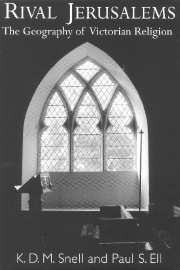Book contents
- Frontmatter
- Contents
- List of figures
- List of tables
- Preface and acknowledgements
- Introduction
- Part 1 Religious geographies: the districts of England and Wales
- Part 2 Religion and locality: parish-level explorations
- 7 A prospect of fifteen counties
- 8 From Henry Compton to Horace Mann: stability or relocation in Catholicism and Nonconformity, and the growth of religious pluralism
- 9 The Sunday school movement: child labour, denominational control and working-class culture
- 10 Free or appropriated sittings: the Anglican Church in perspective
- 11 Conformity, dissent and the influence of landownership
- 12 Urbanisation and regional secularisation
- Technical appendices
- Bibliography
- Index
10 - Free or appropriated sittings: the Anglican Church in perspective
Published online by Cambridge University Press: 08 August 2009
- Frontmatter
- Contents
- List of figures
- List of tables
- Preface and acknowledgements
- Introduction
- Part 1 Religious geographies: the districts of England and Wales
- Part 2 Religion and locality: parish-level explorations
- 7 A prospect of fifteen counties
- 8 From Henry Compton to Horace Mann: stability or relocation in Catholicism and Nonconformity, and the growth of religious pluralism
- 9 The Sunday school movement: child labour, denominational control and working-class culture
- 10 Free or appropriated sittings: the Anglican Church in perspective
- 11 Conformity, dissent and the influence of landownership
- 12 Urbanisation and regional secularisation
- Technical appendices
- Bibliography
- Index
Summary
Looking back over the seventeenth century, Richard Gough organised his History of Myddle around the seating plan of its parish church. As he was so well aware, the spatial apportionment of religious seating was of great significance for the local social order, for parochial belonging and for denominational allegiance. It was an issue of considerable symbolic importance, a hinge that seemed to connect the social order with religious belief. The realities of the local social structure were proclaimed through church seating arrangements, preserved as unquestioned within the House of God, plied into hierarchic forms by master carpenters, and sometimes annointed with a varnished finish. Long after Gough had rung down his curtain, the Victorians remained as fascinated as he had been with the internal seating arrangements of churches and chapels. This concern almost rivalled their interest in external architecture, and it focused upon issues like the availability of sittings, pew appropriation, seat rents and incomes, the relation of sittings to liturgy, the symbolic and social connotations of church seating, or historical precedents for such arrangements.
It is hardly surprising therefore that questions about seating were asked in the Census of Religious Worship. Those questions are of interest to us today not only because they bear on more general issues of religious provision and accessibility, but also because they bring us into touch with certain aspects of local custom and community rather different from the customs researched by social historians.
- Type
- Chapter
- Information
- Rival JerusalemsThe Geography of Victorian Religion, pp. 321 - 363Publisher: Cambridge University PressPrint publication year: 2000
- 1
- Cited by



